The Desktop Kabini Review Part 1: AMD Athlon 5350 (AM1) Tested
by Ian Cutress on April 9, 2014 8:00 AM ESTIGP Comparison, Synthetics
AMD’s graphics stack from top to bottom is all based on the Graphics Core Next architecture. This is an update from earlier VLIW implementations, offering for scalability from low power all the way up to high performance. At the heart of an AMD graphics system is the compute unit comprising of 64 GPU cores. Each compute unit can act independently, ensuring that multiple tasks can complete as quickly as possible due to multiple kernel dispatch across the entire core. In the Kaveri APU launch we were dealing with APUs that contained 6 or 8 compute units for 384/512 cores. With this level of performance, gaming at 1080p30 was possible on most titles depending on how the quality settings were configured. For Kabini, the entire range is given two compute units, with individual processors differing in clock speed.
With two compute units, we are not expecting much from the gaming aspect of these APUs in terms of ‘the latest’ titles. Our benchmarks in the next few pages show that even F1 2013 at 1280x1024 on low settings, unless the engine powering the game is basic, 25 FPS minimum is a hopeful target. This lack of horsepower may limit these APUs to Flash based titles, perhaps even some of the more reasonable Unity games. In AMD’s slide deck they quote games such as Minecraft, Lego Marvel Superheroes and Bastion as the sort of titles that a Kabini player should aim for.
There is some confusion regarding the naming convention of these integrated graphics solutions. Soldered on Kaveri parts designed for all-in-ones, such as the A6-5200, use the HD8000 naming scheme, such as the HD8400. The Athlon 5350 is analogous in design to the A6-5200 except for a 50 MHz speed bump and the name of the IGP – here this is designated as the R3 series. This is despite retailers who are currently selling this APUs and labeling them with the HD8000 designations.
Like Kaveri, the integrated graphics solution in Kabini features an updated Video Codec Engine and Unified Video Decoder giving hardware support for H.264.
AMD is also promoting their Picture Perfect solution, using additional post processing tools to increase video quality on the fly:
Also rather interestingly AMD is claiming an enhanced decoder for JPEG files. Given that one of the primary uses for a Kabini system might be for web access where JPEGs are standard, AMD has been promoting up to a 2x performance increase over a J2900 system:
AMD’s secret sauce, according to their slides, appears to be heterogeneous computing. This would be the ideal usage scenario for computing going forward.
GPU Synthetics
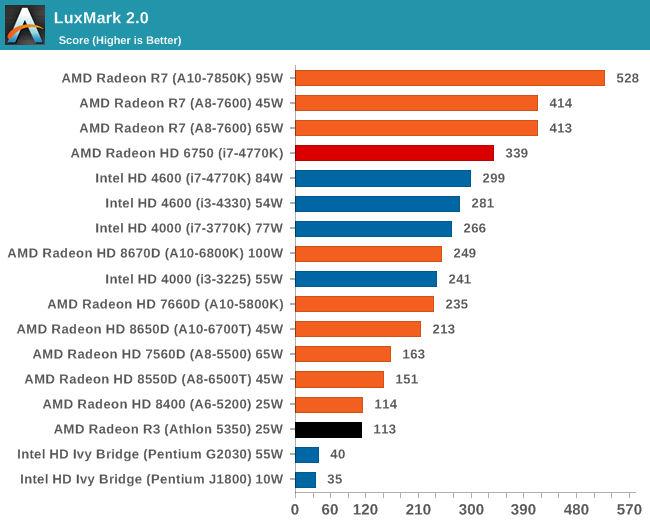
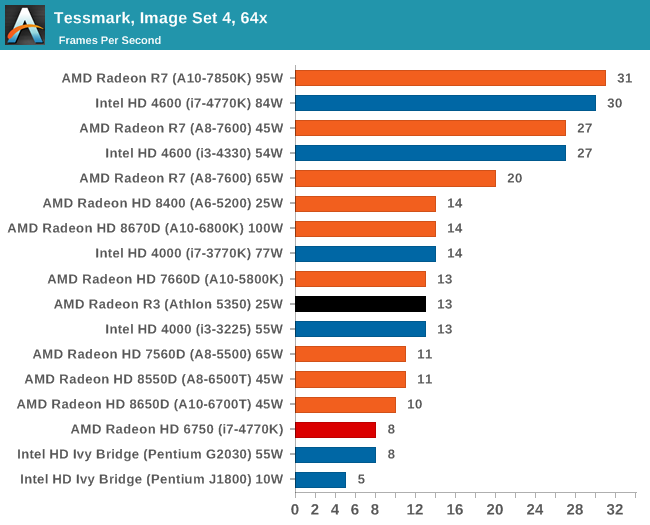


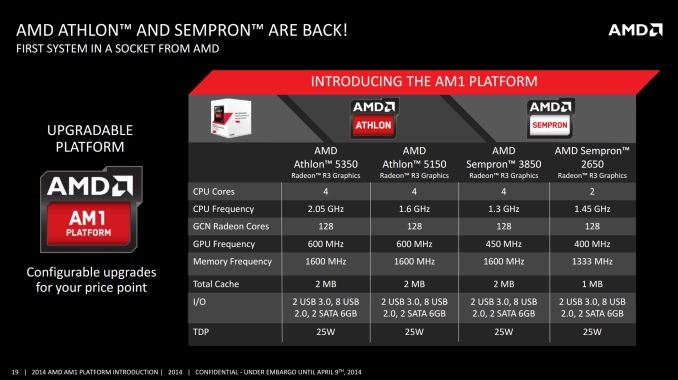
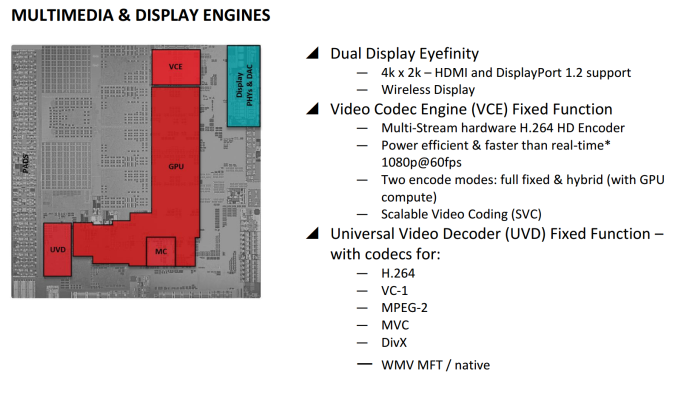
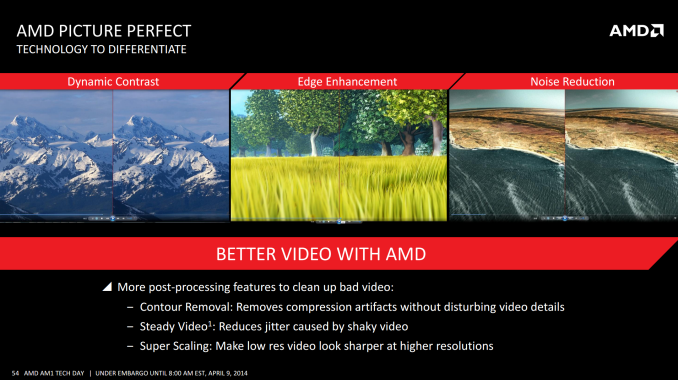
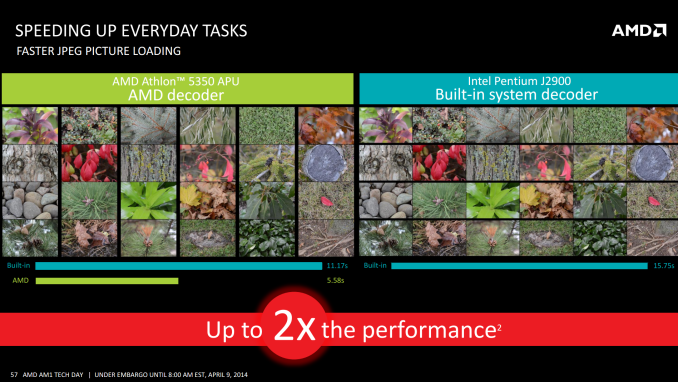
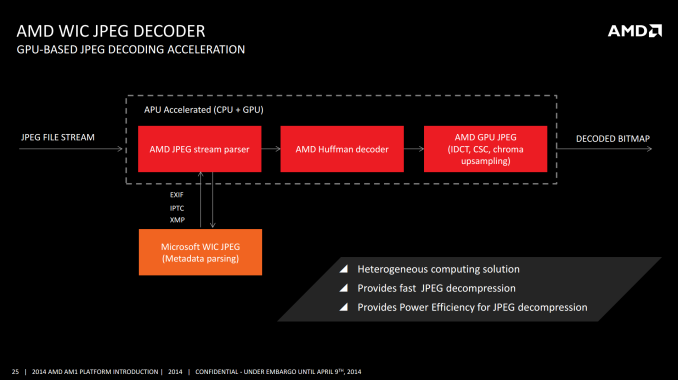








126 Comments
View All Comments
MikeMurphy - Wednesday, April 9, 2014 - link
I'm excited to see this in an upgradeable NUC form factor.jardows2 - Wednesday, April 9, 2014 - link
Please, someone make a thin-mITX for this platform. This is going to be a limited use platform anyway, so there is no reason to put in the full gamut of I/O on the back.jabber - Wednesday, April 9, 2014 - link
Mmm vertically stacked and the size of a paperback book.But whats this...they put the VGA socket at the top! Noooooooooo!
No analogue audio out on the back, just at the front! Noooooooooo!
Yep seen that.
macs - Wednesday, April 9, 2014 - link
Sorry Anandtech but this is not a good review.Where is power consumption data? Comparison with Intel Haswell G1820 (really affordable Haswell chip)? Htpc quality? Older generation (amd e-350)??
Communism - Wednesday, April 9, 2014 - link
They put the newfangled AMD part in the best possible light since they can't afford AMD to be mad at them since AMD pays the bills :PDoes make the a mockery of this Article that it doesn't even include the Intel Haswell G1820 that is it's real competition.
MSRP Intel Haswell G1820 is 42 USD
You can get an H81 board for 49 USD
You can also have real upgradability, since you can go up to a 4670 if you want to.
CiccioB - Wednesday, April 9, 2014 - link
I agree, having a sponsored section on the site isn't really a best thing to avoid any suspicion about bias or favouritism. Any glitch in a review can be seen as a favour to the sponsor. And none will ever know if that's true or not.BTW, I have an Atom D510 (dual physical cores with HT) ITX server which is on 24/24 7/7 used for P2P, backup and some script, stotage and database server. No GFX capacity needed (it is connected to the main PC through Remote Desktop thus "sharing" one of the monitors).
What would be the best solution to replace it if it will eventually die tomorrow?
That Pentium J1800@10W seems very good. Is there something better than that? Consider that power consumption and related fan noise are critical, being always on in my bedroom.
macs - Wednesday, April 9, 2014 - link
I have a similar setup with an AMD e350 itx board. I'm trying to understand if I should upgrade to a newer platform but this review didn't help.Main concern is power consumption, it would be interesting comparing Kabini, BayTrail D and low end Haswell
Communism - Wednesday, April 9, 2014 - link
I can understand not doing the Power Consumption tests, since their standard benching platforms are "Enthusiast" and "Overclocking" motherboards, resulting in higher power consumption of the boards masking the true TDP of the CPU/GPU as a result of the additional chips on the board adding other functionality.They would have to use very sparse basic boards to make the comparison anywhere close to realistic.
jospoortvliet - Thursday, April 10, 2014 - link
Reviews on other sites show AMD consistently beating baytrail at virtually the same active power envelope and much lower idle. Baytrail offers no advantage whatsoever so you can cross that off the list already 😎Beany2013 - Wednesday, April 9, 2014 - link
Try reading the article rather than just looking at the pretty pictures:"As mentioned in our test setup, the benchmark results in this preliminary article are only a small fraction of our normal coverage. Due to other commitments we were unable to run every test on all comparison systems, but we have the other Athlon and Sempron APUs as well as comparable Intel counterparts coming in for review."
Also, the title - Review *Part 1*.
More numbers, compared to competing parts from intel, will be upcoming. It says it in the article - at least twice. It's not ATs problem if you weren't gifted with the good grace to actually read an article before accusing the author of being a shill/being biased/being on the payroll.
Steven R